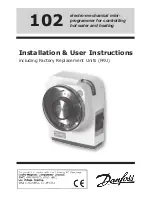
CHAPTER 4. SOFTWARE
GÖPEL electronic GmbH
QNX Neutrino real-time operating system is based on a microkernel architecture, which is characterized by a
clean separation of kernel and application. This makes it possible to execute user programs in their own virtual
memory, which guarantees secure program execution and improves stability. For a smooth porting of existing
program source codes, the UserCode onboard
G-API
uses an image of the familiar Windows
G-API
commands. In
addition, additional functions provide access to event handling, timer tasks, as well as the FLASH file systems and
other operating system resources, as well as to the standard C libraries. In UserCode programming, note that
the processor uses a little-endian byte order. For easier porting, endian conversion macros are included with
the
Net2Run IDE
development system. With the
Net2Run IDE
development system,
GÖPEL electronic
offers a
complete set of development tools for creating UserCode programs and directly executing them on
Serie 62
controller boards. The
Net2Run IDE
development system is based on Eclipse IDE and includes the QNX Neutrino
Command Line Tools (CLT), including compiler, linker and debugger.
UserCode programs can be downloaded and debugged directly from the
Net2Run IDE
via an Ethernet connection.
4.4
Additional Software Interfaces
4.4.1 File System
The software interface ”FS” (File System) allows, among others, to create, copy, delete, run, and finding files on the
hardware. It thus provides unified access to the onboard file system.
4.4.2 Sequence
The software interface ”Sequence” enables the recording and playback of firmware commands as a command se-
quence, in short ”Sequence”. A sequence can also be stored permanently under any name on the device. By spec-
ifying the name, this sequence can be reloaded and played. The automatic loading of a sequence after switching
on the device allows e.g. starting a CAN command sequence to configure a display (if the sequence contains the
necessary commands).
4.4.3 Net2Run
The software interface ”Net2Run” is used to create, configure and execute a residual bus simulation. Several bus
interfaces for CAN, CAN FD, LIN, FlexRay and Ethernet can be simulated simultaneously and coherently. The
Net2Run interface supports the loading and execution of so-called residual bus simulation files (
*.rbs
). These are
preconfigured command sequences that contain a static residual bus simulation. These files are created using
the Net2Run Configurator tool.
Net2Run is divided into several software modules and relies heavily on
AUTOSAR
. There are the software modules:
•
COM
•
PDU Router
•
CAN Interface
•
LIN Interface
•
FlexRay Interface
G CAR 6282
24






































